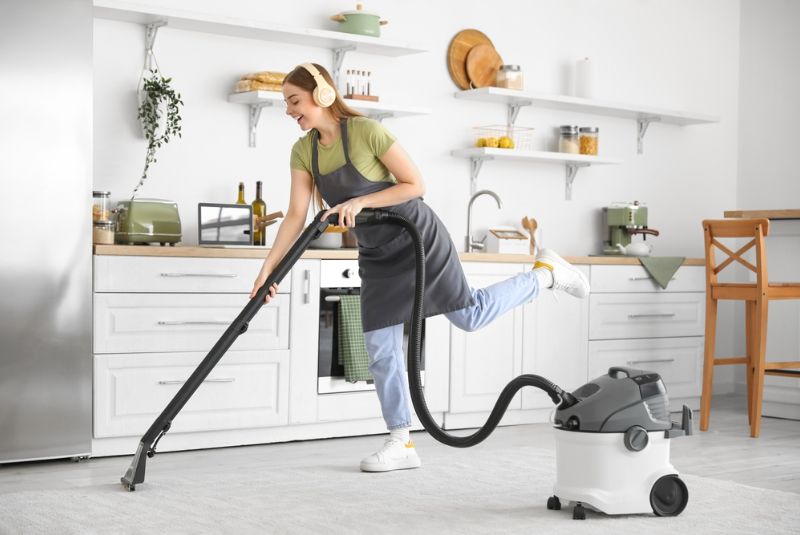Choosing the right vacuum cleaner is crucial for maintaining a clean and healthy home environment. With various models and features available, selecting the best vacuum cleaner can be overwhelming. This comprehensive guide provides essential tips and insights to help you make an informed decision, ensuring your new vacuum cleaner meets your cleaning needs and preferences.
Understanding Different Types of Vacuum Cleaners
Vacuum cleaners come in several types, each designed for specific cleaning tasks. The main types include upright, canister, stick, handheld, and robot vacuums. Upright vacuums are powerful and ideal for deep cleaning carpets. Canister vacuums offer versatility and are great for both carpets and hard floors. Stick vacuums are lightweight and convenient for quick clean-ups. Handheld vacuums are perfect for small messes and hard-to-reach areas. Robot vacuums automate cleaning, providing convenience for busy households. Understanding the different types helps you choose a vacuum cleaner that suits your cleaning needs, ensuring optimal performance and convenience.
Evaluating Suction Power and Performance
Suction power is a key factor in a vacuum cleaner’s effectiveness. Measured in watts or air watts, higher suction power generally means better performance. Consider the type of flooring in your home; powerful suction is essential for deep-cleaning carpets, while moderate suction is sufficient for hard floors. Additionally, look for adjustable suction settings to clean different surfaces without causing damage. Evaluating suction power and performance ensures you choose a vacuum cleaner that effectively removes dirt and debris, keeping your home spotless.
Considering Filtration Systems
A good filtration system is crucial for maintaining indoor air quality, especially for households with allergies or pets. HEPA (High-Efficiency Particulate Air) filters capture 99.97% of particles as small as 0.3 microns, making them ideal for trapping allergens. Some vacuums feature multi-stage filtration systems, combining HEPA filters with other filters to enhance performance. Regular filter maintenance and replacement are essential for optimal efficiency. Considering filtration systems ensures your vacuum cleaner not only cleans surfaces but also improves air quality, contributing to a healthier living environment.
Assessing Bagged vs. Bagless Models
Vacuum cleaners are available in bagged and bagless models, each with its advantages and disadvantages. Bagged vacuums use disposable bags to collect dirt, offering hygienic disposal and reducing dust exposure. They are ideal for allergy sufferers but require ongoing purchase of replacement bags. Bagless vacuums use a dustbin that needs to be emptied regularly, offering convenience and cost savings over time. However, emptying the dustbin can release dust back into the air. Assessing bagged vs. bagless models ensures you choose a vacuum cleaner that fits your preferences and lifestyle, balancing convenience with hygiene.
Evaluating Noise Levels
Noise levels can be a concern, especially for households with young children or pets. Vacuum cleaners vary in noise output, measured in decibels (dB). Models with lower noise levels (around 60-65 dB) are quieter and less disruptive, while higher levels (70 dB and above) can be quite loud. Consider the noise level of the vacuum cleaner and look for models with noise-reducing features. Evaluating noise levels ensures you choose a vacuum cleaner that is comfortable to use without causing unnecessary disturbance, enhancing your cleaning experience.
Considering Weight and Maneuverability
The weight and maneuverability of a vacuum cleaner impact its ease of use. Lightweight models are easier to carry and move around, especially for multi-level homes. Look for vacuums with swivel steering or flexible hoses to navigate around furniture and tight spaces. Adjustable handles and ergonomic designs enhance comfort during use. Considering weight and maneuverability ensures you choose a vacuum cleaner that is easy to handle, making your cleaning tasks more manageable and less strenuous.
Checking for Attachments and Accessories
Attachments and accessories extend the functionality of a vacuum cleaner, allowing you to clean various surfaces and hard-to-reach areas. Common attachments include crevice tools for tight spaces, upholstery brushes for furniture, and dusting brushes for delicate surfaces. Some vacuums come with pet hair attachments or motorized brushes for removing pet hair from carpets and upholstery. Checking for attachments and accessories ensures you choose a vacuum cleaner that meets all your cleaning needs, providing versatility and enhanced performance.
Evaluating Corded vs. Cordless Models
Vacuum cleaners are available in corded and cordless models, each with its benefits. Corded vacuums offer continuous power, making them ideal for extensive cleaning sessions. However, the cord can limit mobility and require frequent outlet changes. Cordless vacuums provide greater mobility and convenience, powered by rechargeable batteries. They are perfect for quick clean-ups and small spaces but may have limited run-time and suction power. Evaluating corded vs. cordless models ensures you choose a vacuum cleaner that fits your cleaning routine and preferences, balancing power with convenience.

Considering Price and Value
Vacuum cleaners come in a range of prices, from budget-friendly options to high-end models with advanced features. Determine your budget and prioritize the features that are most important to you, such as suction power, filtration, and attachments. While higher-priced vacuums often offer better performance and durability, there are many affordable options that provide excellent value. Considering price and value ensures you make a cost-effective purchase that meets your needs and provides long-term satisfaction.
Reading Reviews and Seeking Recommendations
Customer reviews and expert recommendations provide valuable insights into the performance and reliability of different vacuum cleaners. Look for detailed reviews that discuss suction power, ease of use, durability, and overall satisfaction. Professional reviews and consumer reports offer in-depth analysis and comparisons. Additionally, seek recommendations from friends, family, or online communities who have experience with vacuum cleaners. Reading reviews and seeking recommendations ensures you make an informed decision based on real-world experiences and expert opinions.
Testing Before Purchase
If possible, test the vacuum cleaner before making a purchase. Visit stores that offer display models you can try. Assess the suction power, maneuverability, noise level, and ease of use. Pay attention to how comfortable the vacuum feels and how well it performs on different surfaces. Testing before purchase ensures you choose a vacuum cleaner that meets your comfort and functional needs, avoiding potential disappointments after buying. This hands-on experience can provide valuable insights that specifications alone cannot convey.
Supporting Reputable Brands
Choosing a vacuum cleaner from a reputable brand enhances your confidence in your purchase. Established brands often provide better customer support, comprehensive warranties, and a wide range of accessories and replacement parts. Research brands with positive reviews and a history of producing reliable vacuum cleaners. Supporting reputable brands ensures you invest in a product that meets high standards of quality and durability, backed by reliable service.
Considering Warranty and Support
A good warranty and reliable customer support are important when investing in a vacuum cleaner. Look for products that come with a manufacturer’s warranty, covering defects and performance issues. Check the duration and terms of the warranty to understand what is covered. Reliable customer support can assist with product selection, troubleshooting, and resolving any issues that arise. Considering warranty and support ensures you have recourse if problems occur, providing confidence and protection for your investment.
Choosing the right vacuum cleaner involves understanding different types, evaluating suction power and filtration systems, and considering bagged vs. bagless models. Assessing noise levels, weight, maneuverability, and attachments are essential for optimal performance and convenience. Evaluating corded vs. cordless models, considering price and value, and reading reviews further guide your decision. Testing before purchase, supporting reputable brands, and considering warranty and support provide additional assurance. Use this guide to navigate the market confidently and find the perfect vacuum cleaner that offers efficiency, durability, and value for your home cleaning needs.




